These 45 Plants Flower In May – Here’s What Flo Headlam’s Growing In Her Garden

Reviewed By PETER LICKORISH

Peter is a Horticulture Lecturer and self-employed Horticulturist, with a passion for diverse areas of the industry - from garden design to the science behind plant growth and propagation. He has completed the Royal Horticultural Society’s Master of Horticulture (MHort) Award and lectures on RHS courses at Bedford College.
Contributions From FLO HEADLAM

Flo Headlam is a Garden Designer, Writer & TV Presenter. She is currently a Designer and Presenter on BBC Garden Rescue, having previously worked in the BBC Gardeners' World team. Flo has a Diploma in Garden Design from Capel Manor and has experience working on commercial projects and community gardens.

With eight medals from the RHS and other accolades including Best In Show at BBC Gardener’s World Live in 2017, Claudia de Yong is an award-winning Garden Designer based in the UK. Claudia writes for gardening publications such as Houzz UK and is a full member of the Garden Media Guild.
IN THIS GUIDE
- 1) Cornflower
- 2) Common Columbine
- 3) Amaryllis
- 4) Hollyhock
- 5) Mexican Fleabane
- 6) Meadow Clary
- 7) Bear’s Breech
- 8) Giant Onion
- 9) Garden Catmint
- 10) Chinese Dogwood
- 11) Lily ‘Star Gazer’
- 12) Bluebell
- 13) Common Poppy
- 14) Large-Flowered Delphinium
- 15) White Waterlily
- 16) Flowering Grass
- 17) Shasta Daisy
- 18) Bearded Iris
- 19) New Zealand Satin Flower
- 20) Clematis ‘Apple Blossom’
- 21) Bird Of Paradise
- 22) Garden Pansy
- 23) Chinese Wisteria
- 24) Pink Agapanthus
- 25) Wild Cherry
- 26) Sweet Pea
- 27) Common Yarrow
- 28) Jacob’s Ladder
- 29) Wood Avens
- 30) Yellow Corydalis
- 31) Common Solomon’s Seal
- 32) Arum Lily
- 33) Clematis ‘Lasurstern’
- 34) Common Dog Violet
- 35) Purple Spiderwort
- 36) Common Lilac
- 37) Magnolia ‘Susan’
- 38) Black Parsley
- 39) Blue Poppy
- 40) Mexican Mock Orange
- 41) Renard Geranium
- 42) Turban Lily
- 43) Narrow-Leaved Sundrops
- 44) Mediterranean Spurge
- 45) Rose ‘Canary Bird’
As the end of spring approaches, the chance of frost decreases and there are plenty of flowers that can finally bloom.
“There is a wonderful freshness about the month of May in the garden,” shares Claudia de Yong, a Designer.
“Everything appears new and presents us with a taste of what’s to come and I especially love all the fruit blossoms.”
May is one of the best times of year for gardeners in the UK, as Garden Designer Flo Headlam shares:
“At the moment there are some plants in my garden that are looking really well.
“I’m growing a Deutzia pulchra and that is a bee magnet. I’ve got some Geum ‘Totally Tangerine’ that have been flowering for the past month and they are looking great.
“My flag irises are also looking lovely right now. I’ve also got Spiraea japonica ‘Goldflame’ which is just stunning, with all the different pink, yellow and green shades that have appeared just before the flowers have come out.
“My May garden is looking very fresh!”
There are hundreds of other plants that will start to bloom, pollinators will be out in full force and the weather should allow for more time spent outdoors tending to and appreciating your garden.
“Right now I’m growing a variety of flowers, vegetables and herbs,” shares Hannah Reid, a Professional Gardener.
“The flowers are mainly edible including sunflowers, nasturtiums, calendula, marigolds and viola.”
In this guide, we share fourty-five(!) of our favourite plants that are in bloom throughout the month of May.
1) Cornflower

- BOTANICAL NAME: Centaurea cyanus
- HARDINESS RATING: H6
- PLANT TYPE: annual
- FLOWERS: blue
- FLOWERING SEASON(S): spring / summer
- SIZE: 0.5-1m in height, 0.1-0.5m spread
Cornflowers are a popular garden flower and a great way to kick off this list.
Bursting into a bright blue colour in May, cornflowers produce frilly flowers on the top of tall stems, that reach up to 1m in height, which tend to bloom until the first frosts in September.
Plant your cornflowers in a position in full sun in wildflower displays or in your flower beds or borders.
2) Common Columbine

- BOTANICAL NAME: Aquilegia vulgaris
- HARDINESS RATING: H7
- PLANT TYPE: perennial
- FLOWERS: blue and purple
- FLOWERING SEASON(S): spring / summer
- SIZE: 0.5-1m in height, 0.1-0.5m spread
A fully-hardy perennial, Aquilegia vulgaris, also known as common columbine, is a low-maintenance plant that bears trumpet-shaped flowers in shades of blue and purple from late spring into summer.
This plant looks great in cottage garden planting schemes and can also be used for underplanting larger flowering shrubs or trees.
3) Amaryllis

- BOTANICAL NAME: Hippeastrum
- HARDINESS RATING: H2
- PLANT TYPE: perennial / bulb
- FLOWERS: varies
- FLOWERING SEASON(S): winter / spring
- SIZE: 0.1-0.5m in height, 0.1-0.5m spread
Amaryllis is a bulbous perennial that bears beautiful flowers from winter that lasts until the end of May.
Commonly grown as a houseplant here in the UK, these festive blooms that come in various shades can brighten up your home on the darker days of the year until the sun arrives.
4) Hollyhock

- BOTANICAL NAME: Alcea rosea
- HARDINESS RATING: H5
- PLANT TYPE: biennial
- FLOWERS: yellow, white, red, purple and pink
- FLOWERING SEASON(S): summer
- SIZE: 1.5-2.5m in height, 0.5-1m spread
With funnel-shaped flowers that grow on stems up to 2.5m tall, hollyhock is a wonderful addition to traditional cottage garden displays or for use in a mixed border.
As biennials, individual plants will only bloom for a year or two, but I think the colour that they provide from May into late summer is worth it.
They also self-seed fairly freely.
5) Mexican Fleabane
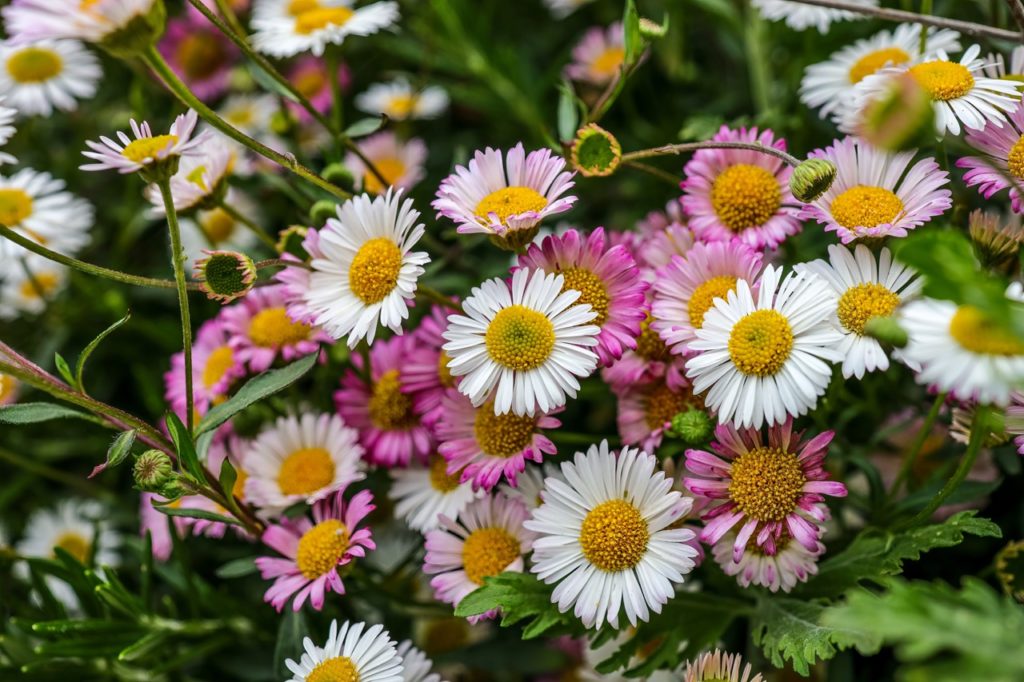
- BOTANICAL NAME: Erigeron karvinskianus
- HARDINESS RATING: H5
- PLANT TYPE: perennial
- FLOWERS: pink, white and purple
- FLOWERING SEASON(S): summer
- SIZE: 0.1-0.5m in height, 0.5-1m spread
Producing daisy-like flowers from as early as May, Mexican fleabane is a small, spreading perennial that is a great plant for ground cover and filling up the space in your garden beds.
Not only that, but they will also provide a beautiful burst of pink, white and purple when they bloom.
Grow Mexican fleabane in an exposed position in full sun.
6) Meadow Clary
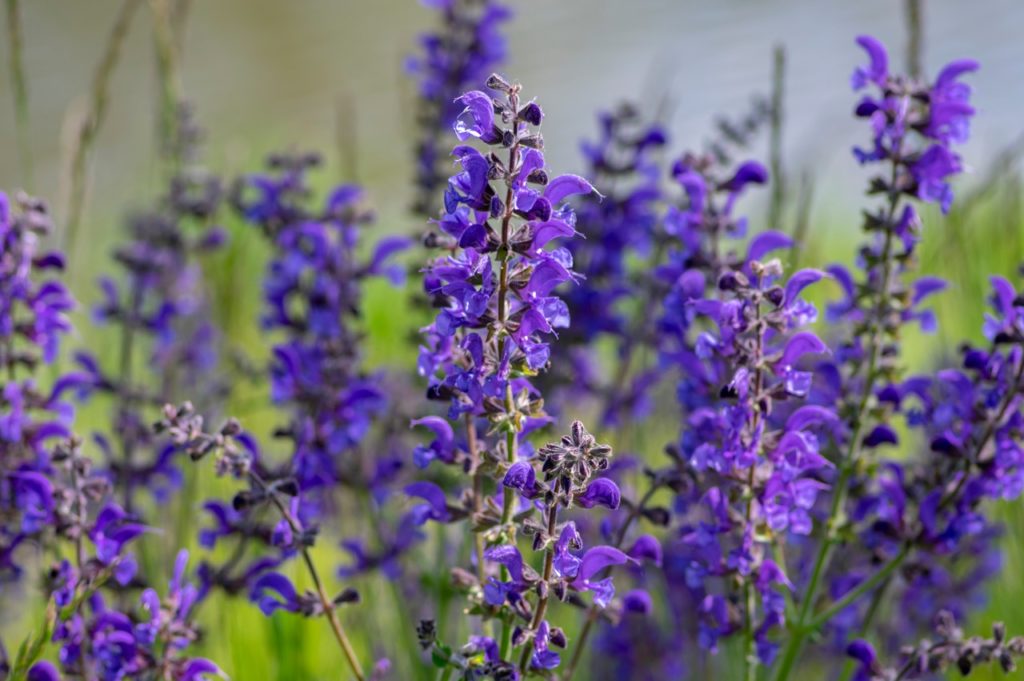
- BOTANICAL NAME: Salvia pratensis
- HARDINESS RATING: H7
- PLANT TYPE: perennial
- FLOWERS: white, blue and pink
- FLOWERING SEASON(S): summer
- SIZE: 0.5-1m in height, 0.1-0.5m spread
With crinkled green leaves and unusually shaped flowers, Salvia pratensis, or meadow clary, is an easy-to-care-for perennial that produces blue or purple flowers from May onwards.
Growing up to 1m tall, make sure meadow clary is positioned somewhere it will receive full sun and it will reward you with blooms all summer long.
7) Bear’s Breech
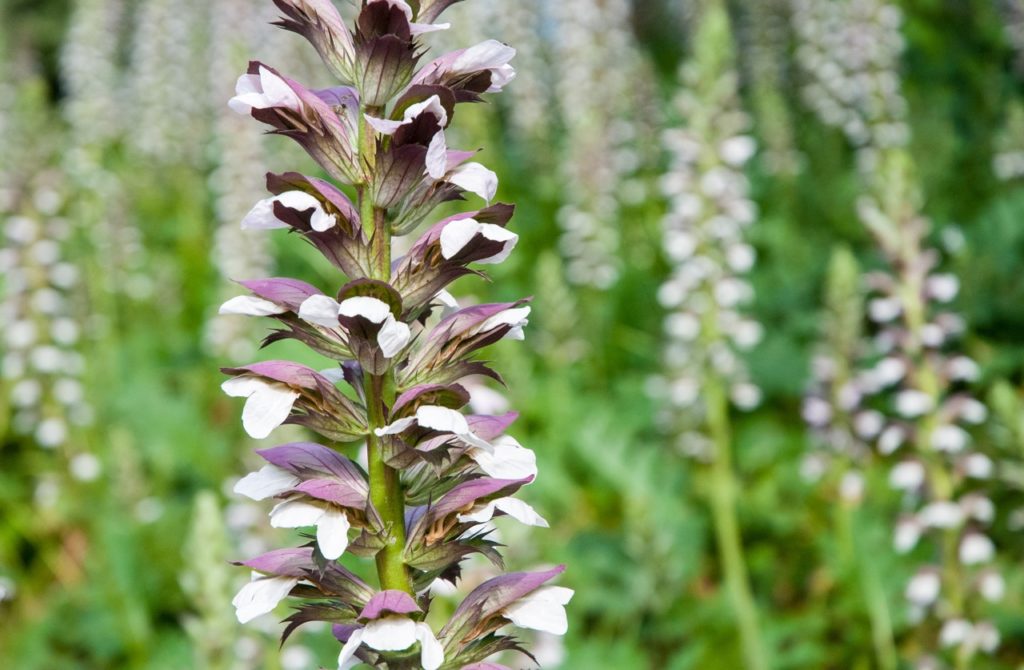
- BOTANICAL NAME: Acanthus mollis
- HARDINESS RATING: H6
- PLANT TYPE: perennial
- FLOWERS: white and purple
- FLOWERING SEASON(S): summer
- SIZE: 1-1.5m in height, 1-1.5m spread
A relatively unfussy plant, Acanthus mollis can be grown in most conditions and will look best in a mixed garden bed with other perennials.
Its flowers are white and are concealed by purple bracts growing on erect racemes that can reach heights of up to 1.5m.
8) Giant Onion

- BOTANICAL NAME: Allium giganteum
- HARDINESS RATING: H5
- PLANT TYPE: perennial / bulb
- FLOWERS: purple
- FLOWERING SEASON(S): summer
- SIZE: 1-1.5m in height, 0.1-0.5m spread
Allium giganteum, a variety commonly referred to as the giant onion, produces a rounded cluster of tiny purple flowers atop tall stems from May until August that are beloved by bees and other pollinators.
The giant onion can be grown in flower borders or beds and its flowers can be cut to be used for displays inside your home, or leave the seed-heads to keep their unusual forms in your borders.
9) Garden Catmint
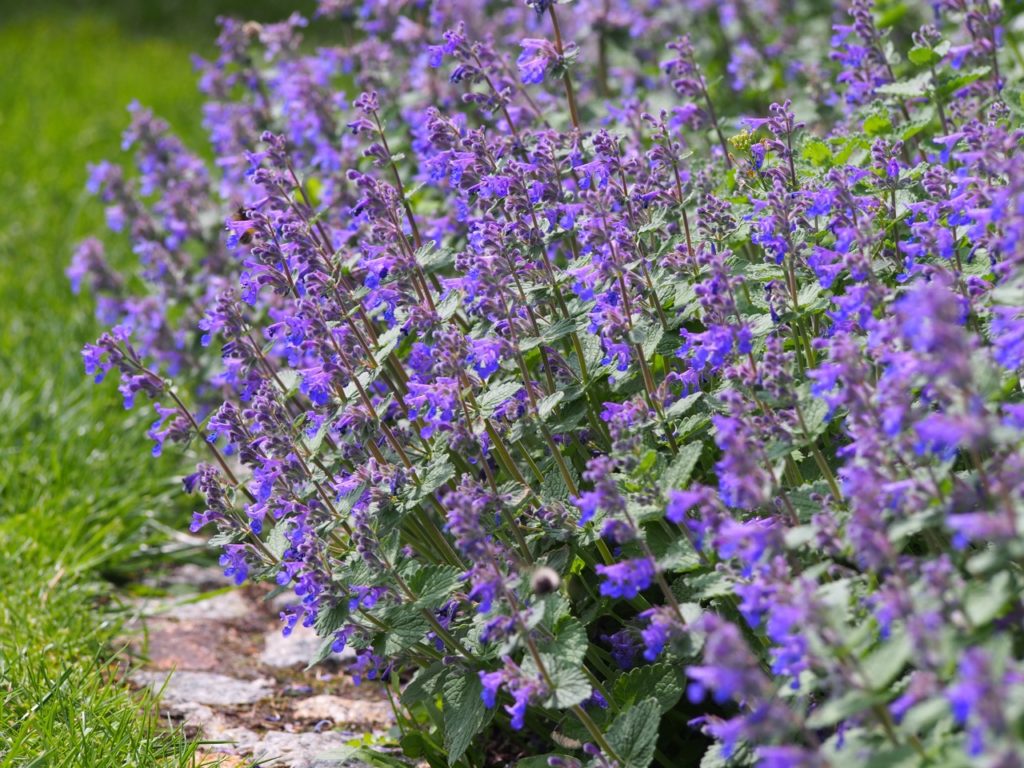
- BOTANICAL NAME: Nepeta × faassenii
- HARDINESS RATING: H7
- PLANT TYPE: perennial
- FLOWERS: blue
- FLOWERING SEASON(S): summer / autumn
- SIZE: 0.1-0.5m in height, 0.1-0.5m spread
With flowers appearing from May that last well into autumn, garden catmint is a small, clump-forming perennial with a distinctive, pungent aroma.
This small-growing plant will be a great addition to wildlife-friendly displays as it is a great plant for pollinators when in flower.
It might also attract local felines so only place it in areas of your garden that you’re happy to be visited by cats.
10) Chinese Dogwood
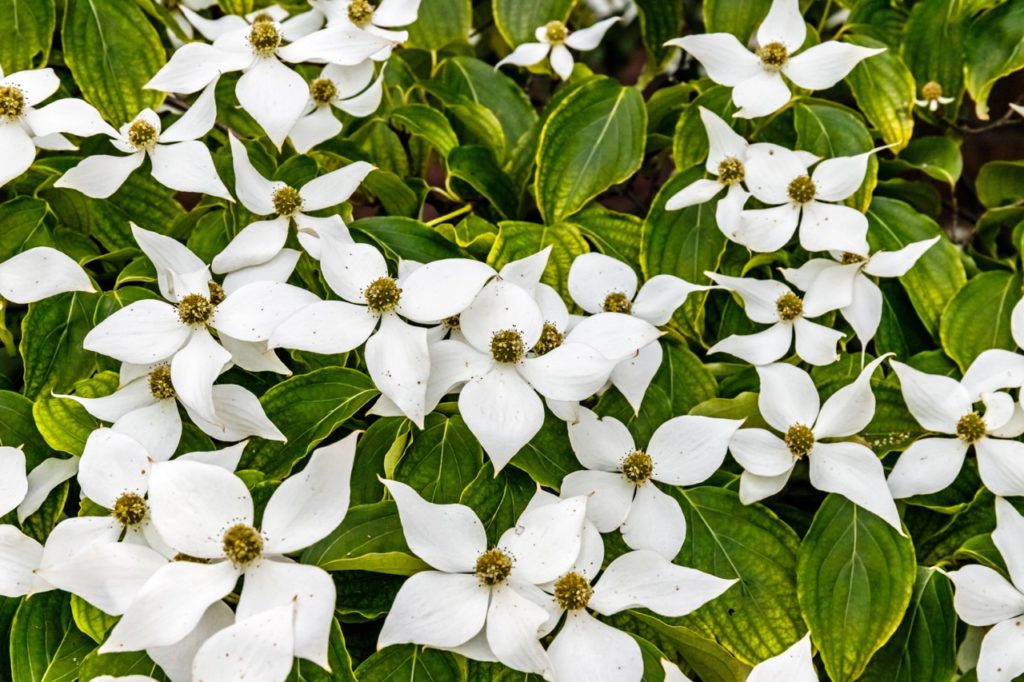
- BOTANICAL NAME: Cornus kousa var. chinensis
- HARDINESS RATING: H6
- PLANT TYPE: tree / shrub
- FLOWERS: cream
- FLOWERING SEASON(S): late spring / summer
- SIZE: 4-8m in height, 4-8m spread
Chinese dogwood, either grown as a shrub or a tree, is a unique plant that has orange and red foliage in the autumn months.
More importantly, creamy-white flowers appear in late spring and should stick around until summer.
This may-flowering shrub will look great at the back of borders with its distinctive shapes and can even be used for garden hedging.
11) Lily ‘Star Gazer’
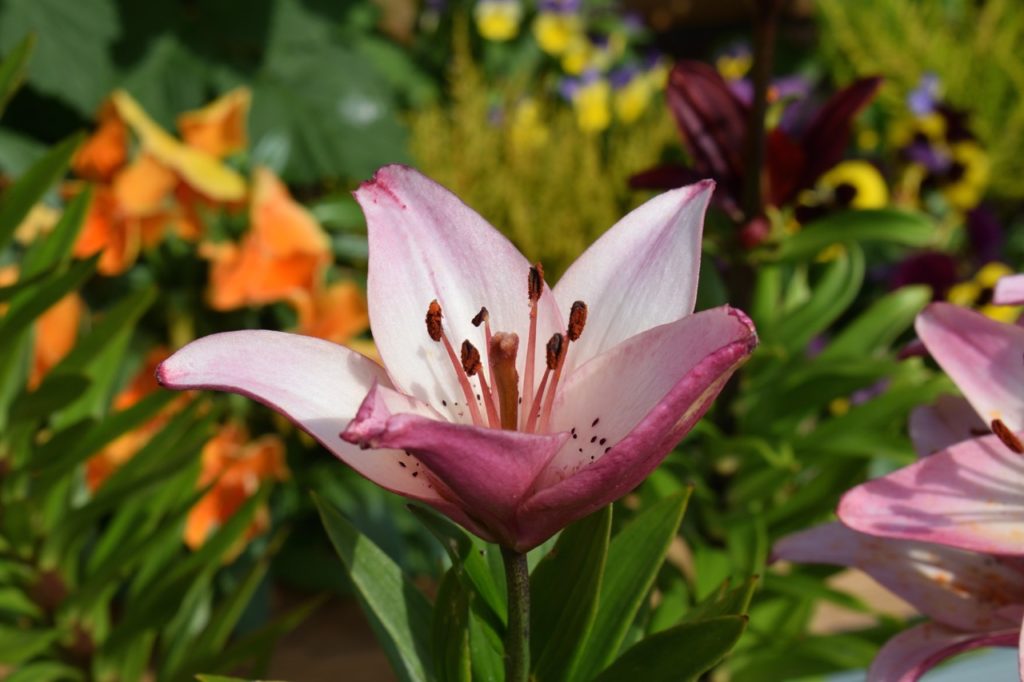
- BOTANICAL NAME: Lilium ‘Star Gazer’
- HARDINESS RATING: H6
- PLANT TYPE: bulb
- FLOWERS: pink
- FLOWERING SEASON(S): summer
- SIZE: 1-1.5m in height, 0.1-0.5m spread
Lots of lilies flower in May, but ‘Star Gazer’ showcases beautiful pink flowers, edged with white, that peel back to reveal brown spots in the middle of its petals.
Overwintering pots in a greenhouse should bring forward flowering, to achieve May blooms.
I think lilies look best in container displays, whether planted alone or as part of a lasagne bulb planting scheme.
12) Bluebell

- BOTANICAL NAME: Hyacinthoides non-scripta
- HARDINESS RATING: H6
- PLANT TYPE: bulb / perennial
- FLOWERS: white and blue
- FLOWERING SEASON(S): spring
- SIZE: 0.1-0.5m in height, 0-0.1m spread
Bluebells are popular in the UK as they are fully hardy and easy to grow and care for.
Their beautiful blue flowers grow at the end of arching stems, creating the drooping effect that they are usually known for.
Bluebells grow best in partial shade, making them great for planting underneath larger shrubs or in a shaded spot in your garden.
13) Common Poppy
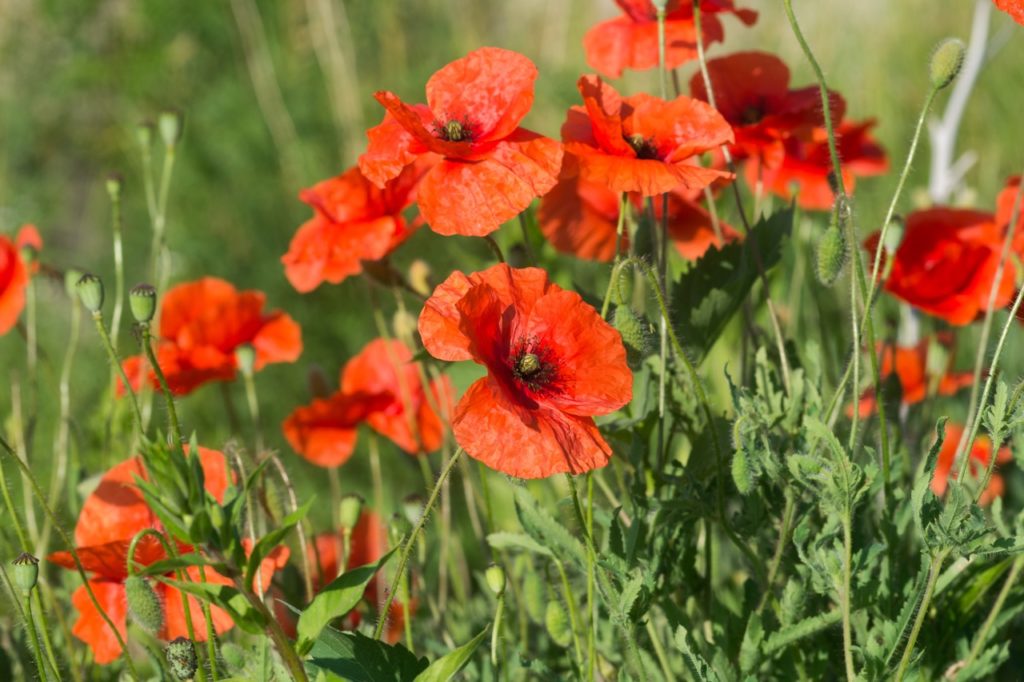
- BOTANICAL NAME: Papaver rhoeas
- HARDINESS RATING: H7
- PLANT TYPE: annual
- FLOWERS: red
- FLOWERING SEASON(S): summer
- SIZE: 0.5-1m in height, 0.1-0.5m spread
Papaver rhoeas, the common poppy, is another flower that is favoured here in the UK.
Grown as an annual, this wildflower will flower as early as May (though often you may need to wait until mid-June) and looks best in a meadow display.
It will thrive and flower best if planted in a spot that receives full sun.
14) Large-Flowered Delphinium
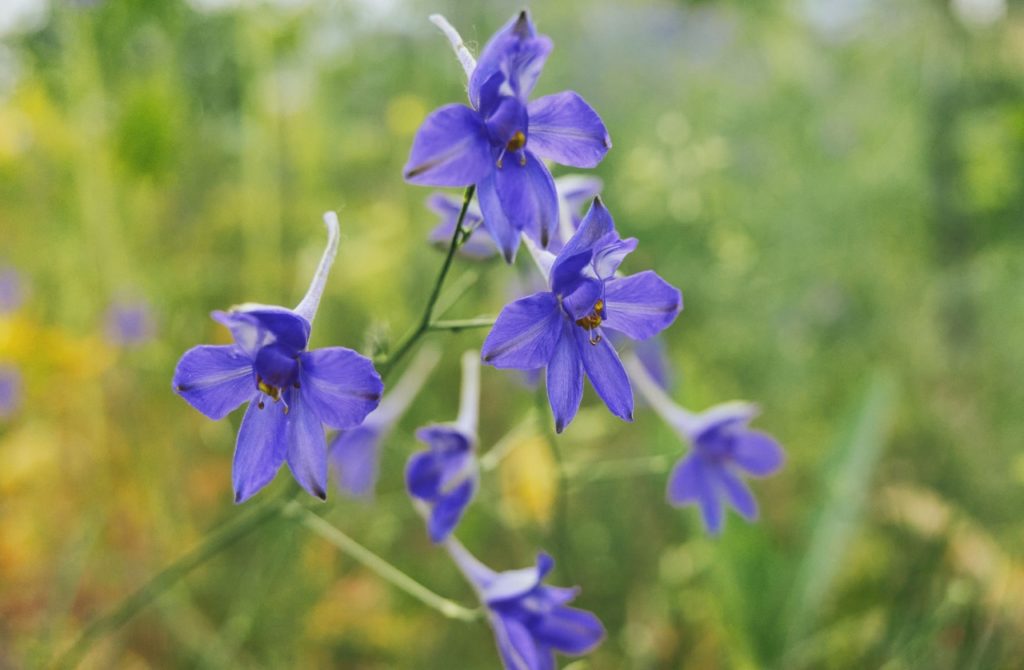
- BOTANICAL NAME: Delphinium grandiflorum
- HARDINESS RATING: H5
- PLANT TYPE: annual / perennial
- FLOWERS: blue, white and purple
- FLOWERING SEASON(S): summer
- SIZE: 0.1-0.5m in height, 0.1-0.5m spread
Flowering from May until August, Delphinium grandiflorum is also a short-lived perennial suited to wildflower meadow planting.
However, unlike the common poppy, this plant needs both full sun and a sheltered position.
Make sure you meet these needs to ensure your delphinium starts flowering in May.
15) White Waterlily

- BOTANICAL NAME: Nymphaea alba
- HARDINESS RATING: H5
- PLANT TYPE: aquatic
- FLOWERS: white
- FLOWERING SEASON(S): summer
- SIZE: 0-0.1m in height, 1-1.5m spread
Perhaps the most unusual option on this list, the white waterlily produces beautiful open blooms with yellow stamen at the centre from May through to August.
This aquatic plant should be grown in water that does not get disturbed, or in a pot with a waterlogged, loam-based growing medium.
16) Flowering Grass
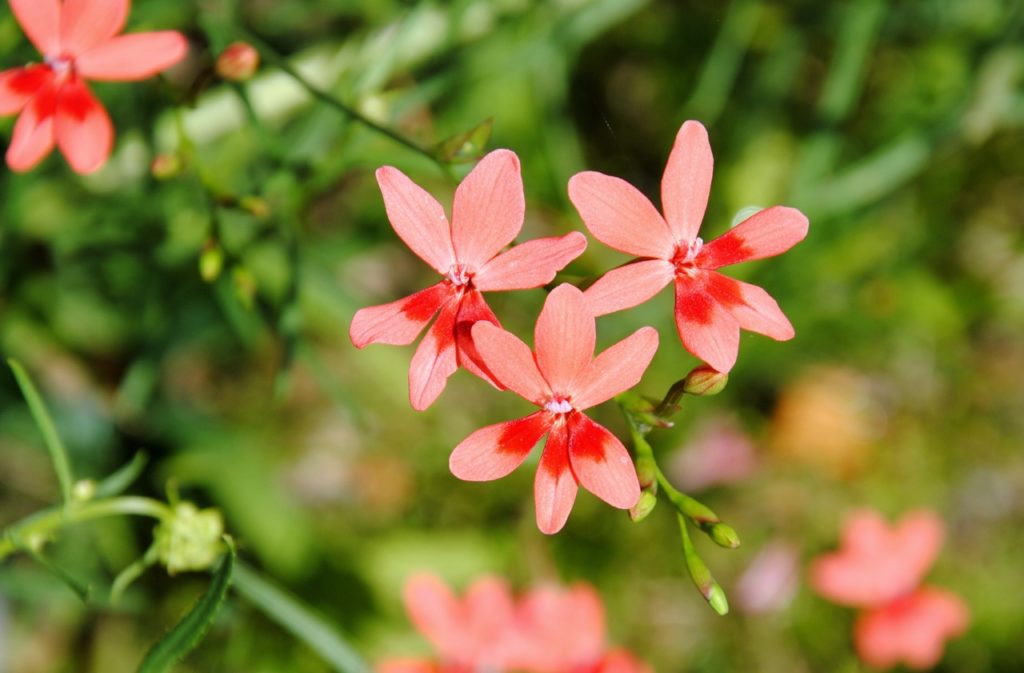
- BOTANICAL NAME: Freesia laxa
- HARDINESS RATING: H3
- PLANT TYPE: perennial
- FLOWERS: red
- FLOWERING SEASON(S): summer
- SIZE: 0.1-0.5m in height, 0-0.1m spread
Freesia laxa, also known as flowering grass, is a frost-tender perennial that produces peachy-coloured blooms at the start of summer, sometimes as early as May.
This small perennial prefers an acidic growing medium and might need some additional care over the winter months.
17) Shasta Daisy

- BOTANICAL NAME: Leucanthemum × superbum
- HARDINESS RATING: H5
- PLANT TYPE: perennial
- FLOWERS: yellow and white
- FLOWERING SEASON(S): summer / autumn
- SIZE: 0.5-1m in height, 0.5-1m spread
Leucanthemum × superbum, more commonly known as Shasta daisies, are perennials that are in bloom from May until the end of autumn.
With white and yellow daisy-like flowers that grow on stems up to 1m high, these wildflowers and their long-lasting blooms are a great choice if you are after long-lasting blooms.
Shasta daisies should be grown in a sheltered location and can look great in a flower bed or herbaceous border.
18) Bearded Iris
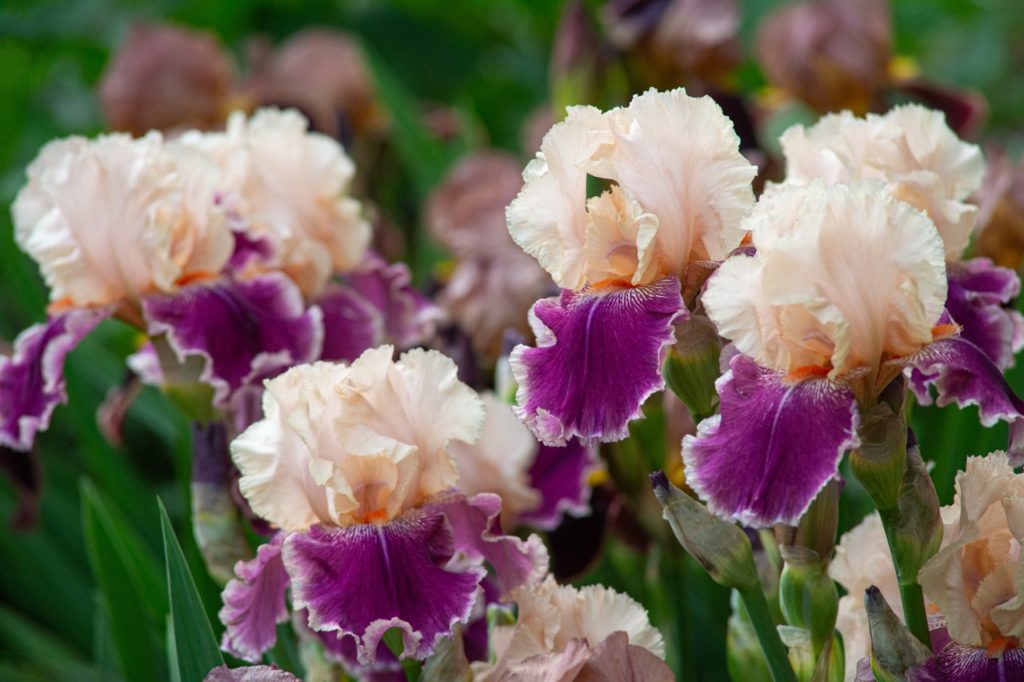
- BOTANICAL NAME: Iris germanica
- HARDINESS RATING: H6
- PLANT TYPE: perennial
- FLOWERS: various
- FLOWERING SEASON(S): late spring / early summer
- SIZE: 0.5-1m in height, 0.1-0.5m spread
With blooms that last until the start of June, the bearded iris produces frilly flowers that are often bicoloured.
These gorgeous perennials prefer a growing medium and should be positioned somewhere where they will receive plenty of sun, including on their rhizomes.
19) New Zealand Satin Flower

- BOTANICAL NAME: Libertia chilensis
- HARDINESS RATING: H3
- PLANT TYPE: perennial
- FLOWERS: white
- FLOWERING SEASON(S): spring / summer
- SIZE: 0.5-1m in height, 0.5-1m spread
Producing clusters of white star-shaped flowers on woody stems at the end of spring, the New Zealand satin flower is a lovely perennial that is often used in gravel gardens.
This frost-tender plant will need to be mulched over the winter months to protect it from the cold.
20) Clematis ‘Apple Blossom’
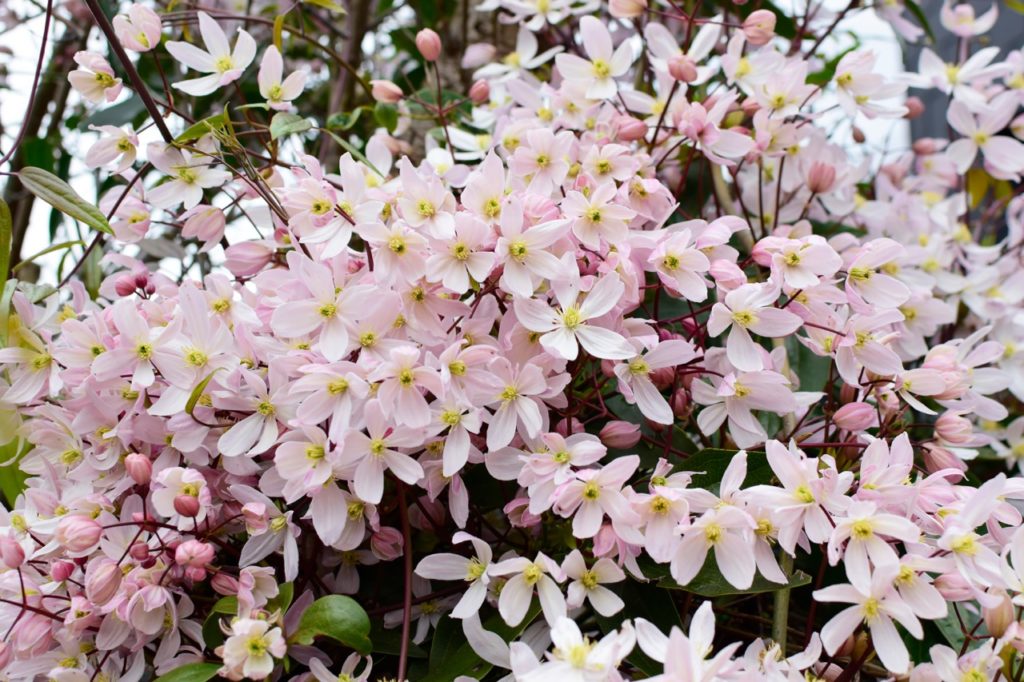
- BOTANICAL NAME: Clematis ‘Apple Blossom’
- HARDINESS RATING: H4
- PLANT TYPE: shrub / climber
- FLOWERS: pink
- FLOWERING SEASON(S): spring / summer
- SIZE: 4-8m in height, 1.5-2.5m spread
Clematis ‘Apple Blossom’ is a great choice for garden hedging and natural screening and can also work well in flower borders if you have the space for such a tall feature.
This floriferous shrub bears pale pink blossoms from May onwards and can also be trained against a wall or trellis if you’re looking for a decorative addition to your garden.
21) Bird Of Paradise

- BOTANICAL NAME: Strelitzia reginae
- HARDINESS RATING: H1B
- PLANT TYPE: perennial / houseplant
- FLOWERS: orange and blue
- FLOWERING SEASON(S): winter / spring
- SIZE: 1-1.5m in height, 0.5-1m spread
With stunning orange and blue flowers that resemble the shape of a bird’s head and beak, the bird of paradise plant is unlike any other.
Its blooms appear from winter but can last until the end of May if the plant is cared for properly.
Grow birds of paradise as houseplants or in a heated greenhouse where temperatures consistently remain above 10°C.
22) Garden Pansy

- BOTANICAL NAME: Viola × wittrockiana
- HARDINESS RATING: H6
- PLANT TYPE: annual
- FLOWERS: purple, yellow and blue
- FLOWERING SEASON(S): summer
- SIZE: 0.1-0.5m in height, 0.1-0.5m spread
Viola × wittrockiana, more commonly known as garden pansies, produce bicoloured flowers that come in various shades of yellow, blue and purple.
These colourful flowers will complement and grow well with other May-flowering annuals on this list, such as poppies, to create a mixed annual display.
23) Chinese Wisteria
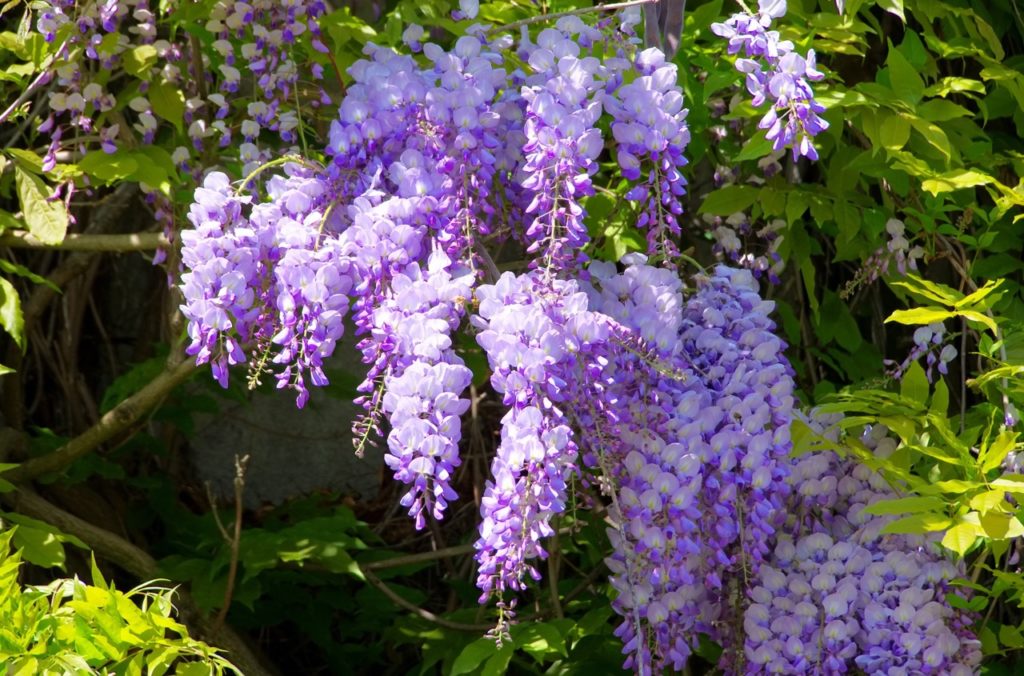
- BOTANICAL NAME: Wisteria sinensis
- HARDINESS RATING: H6
- PLANT TYPE: shrub / climber
- FLOWERS: purple
- FLOWERING SEASON(S): spring / summer
- SIZE: 12m in height, 8m spread
I love wisterias, and this species is no exception.
Producing cascading purple flowers from May to August, this large shrub can grow 10-12m in height with two-thirds of the spread – more than enough to cover the outside of a home or garden wall.
Grow your Chinese wisteria at the back of a garden border against a fence, wall or trellis for a floriferous backdrop like no other.
24) Pink Agapanthus
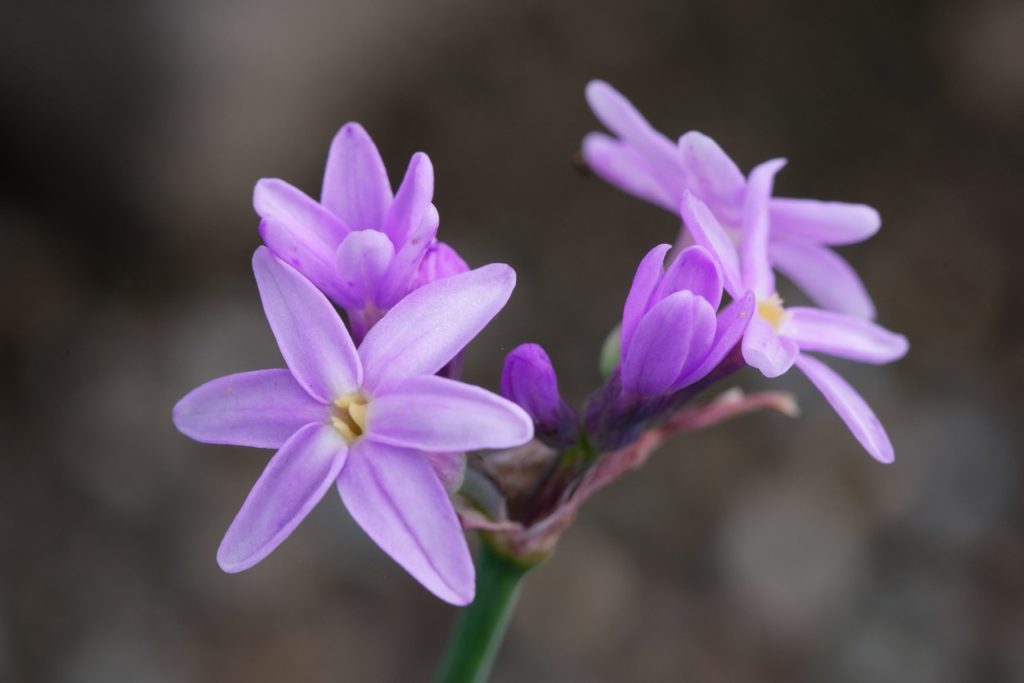
- BOTANICAL NAME: Tulbaghia fragrans
- HARDINESS RATING: H3
- PLANT TYPE: perennial
- FLOWERS: purple
- FLOWERING SEASON(S): summer / autumn
- SIZE: 0.1-0.5m in height, 0.1-0.5m spread
With star-shaped lilac flowers that provide a wonderful (distinct) aroma during flowering, pink agapanthus plants are a sweet addition to garden displays.
As they are frost-tender plants, I’d recommend growing these dainty perennials in containers so they can be brought indoors during the colder months.
Flowering starts in late May and can continue long into Autumn.
25) Wild Cherry

- BOTANICAL NAME: Prunus avium
- HARDINESS RATING: H6
- PLANT TYPE: tree
- FLOWERS: white
- FLOWERING SEASON(S): spring
- SIZE: 12m in height, 8m spread
A large tree, wild cherry bears clusters of white flowers in May that are followed by plump red cherries that can be harvested in the autumn months.
Once planted, this deciduous tree is easy to care for as long as it receives plenty of sunshine throughout the day.
However, bear in mind before planting that this tree can grow over 10 metres in height and its roots are fairly shallow, so if you don’t have the space, this is definitely not the plant for you.
26) Sweet Pea
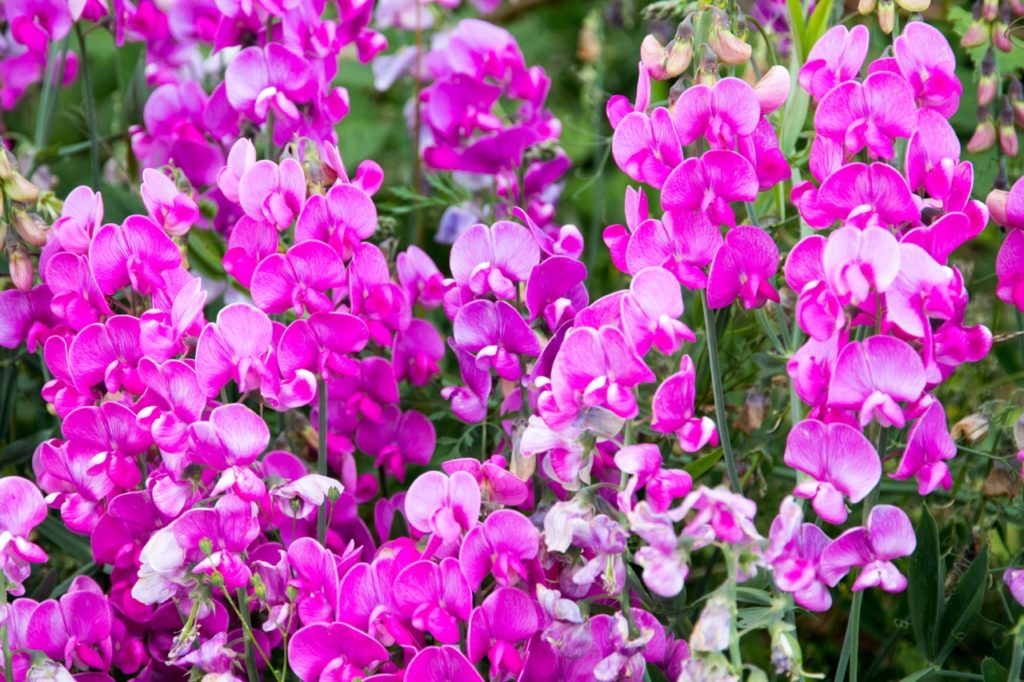
- BOTANICAL NAME: Lathyrus odoratus
- HARDINESS RATING: H3
- PLANT TYPE: annual / climber
- FLOWERS: purple and red
- FLOWERING SEASON(S): summer / autumn
- SIZE: 1.5-2.5m in height, 0.1-0.5m spread
Frost-tender annuals, sweet pea plants produce beautifully scented flowers on tall spikes that can reach up to 2m in height.
Available in various shades of purple and red, this voracious grower will enthusiastically climb vertical trellis or fencing.
To increase your chances of getting flowers in May, consider an early variety such as ‘Painted Lady’ and sow in the autumn.
27) Common Yarrow

- BOTANICAL NAME: Achillea millefolium
- HARDINESS RATING: H7
- PLANT TYPE: perennial
- FLOWERS: white, cream, yellow and pink
- FLOWERING SEASON(S): summer
- SIZE: 0.1-0.5m in height, 0.1-0.5m spread
Achillea millefolium, or yarrow, is a fully hardy perennial that, when grown in full sun, will produce an abundance of bright yellow or pink flowers from as early as May right through to the end of August.
It tolerates dry soil and is a magnet for insects.
28) Jacob’s Ladder
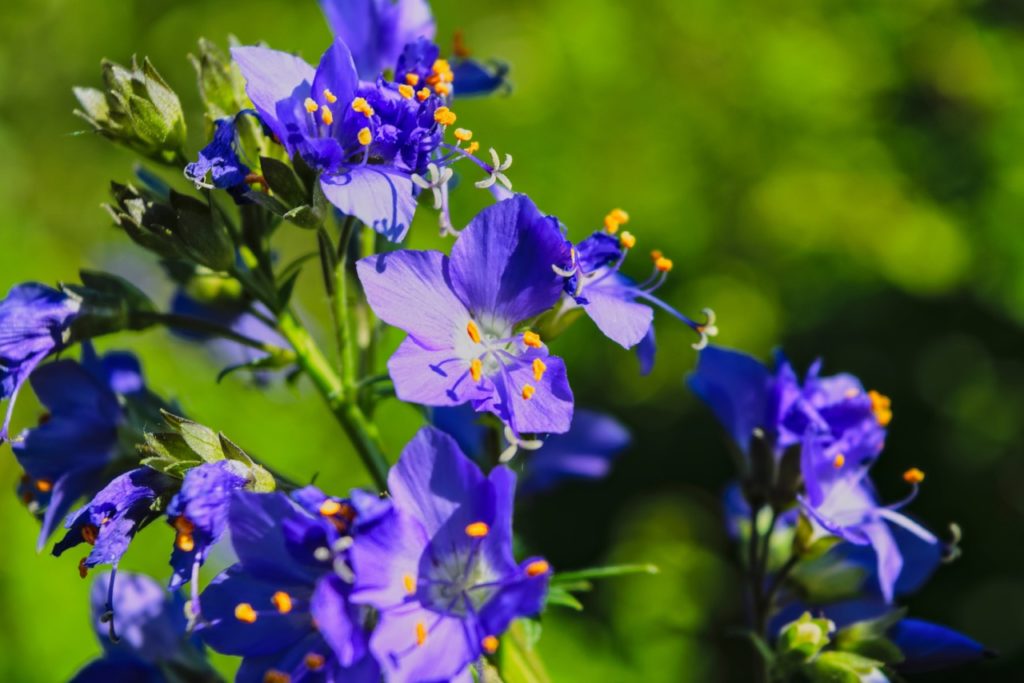
- BOTANICAL NAME: Polemonium caeruleum
- HARDINESS RATING: H7
- PLANT TYPE: perennial
- FLOWERS: blue
- FLOWERING SEASON(S): summer
- SIZE: 0.5-1m in height, 0.1-0.5m spread
With blue blooms that arrive in May, Jacob’s ladder is a fully-hardy perennial that is easy to care for once planted out.
Growing up to 1m tall with half the spread, this bushy plant with cupped flowers will return year after year with minimal intervention.
29) Wood Avens
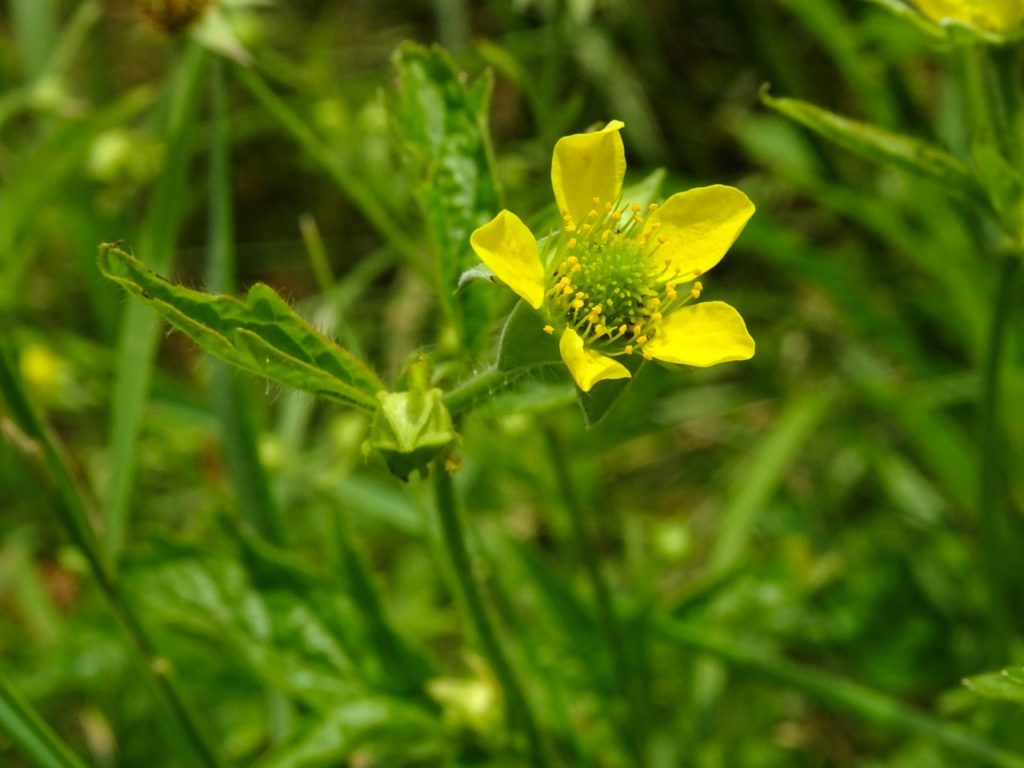
- BOTANICAL NAME: Geum urbanum
- HARDINESS RATING: H7
- PLANT TYPE: perennial
- FLOWERS: yellow
- FLOWERING SEASON(S): spring / summer / autumn
- SIZE: 0.5-1m in height, 0.1-0.5m spread
Wood avens produce lovely yellow flowers in the late spring until the first frosts.
The long-lasting blooms are also great for wildlife.
Grow wood avens with other low-maintenance wildflowers for natural displays.
“I would caution against planting this plant unless you have the space for it,” shares Master Horticulturist Peter Lickorish.
“It is a good wildflower for shade, but it self-seeds prolifically and can quickly take over mixed borders.
“It’s also a very tricky plant to dig up and remove, thanks to the strength of its roots. Pick its position wisely.”
30) Yellow Corydalis
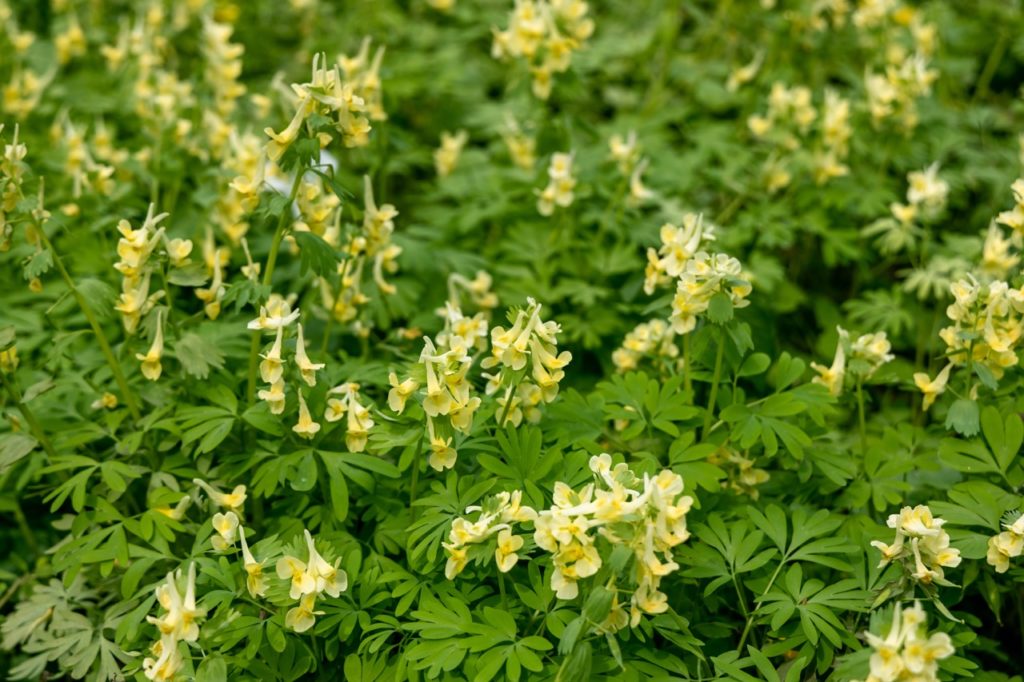
- BOTANICAL NAME: Corydalis lutea
- HARDINESS RATING: H5
- PLANT TYPE: perennial
- FLOWERS: yellow
- FLOWERING SEASON(S): spring / summer
- SIZE: 0.1-0.5m in height, 0.1-0.5m spread
Another yellow-flowering perennial, the creamy blooms from this corydalis plant can look right at home when planted in a rock or gravel garden.
Corydalis lutea needs to be planted in a shaded site and will not flower well if grown in too much sun.
It also goes under the name Fumaria.
31) Common Solomon’s Seal
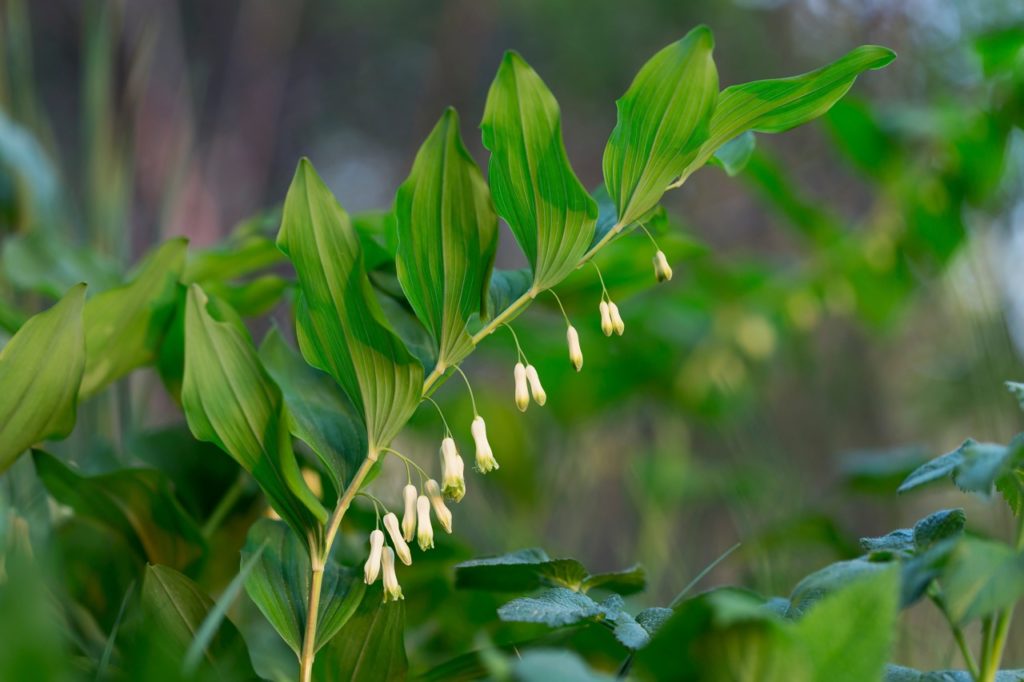
- BOTANICAL NAME: Polygonatum multiflorum
- HARDINESS RATING: H7
- PLANT TYPE: perennial
- FLOWERS: white and green
- FLOWERING SEASON(S): spring
- SIZE: 0.5-1m in height, 01.-0.5m spread
Common Solomon’s seal is an unusual perennial that produces flowers in spring that last until the end of May, or sometimes even longer.
The flowers are tubular and white with green tips, growing from long arching stems that reach up to 1m tall.
With large, crinkled leaves, this plant will look great in a foliage display or in a flowering border that is in need of some green ground cover.
32) Arum Lily
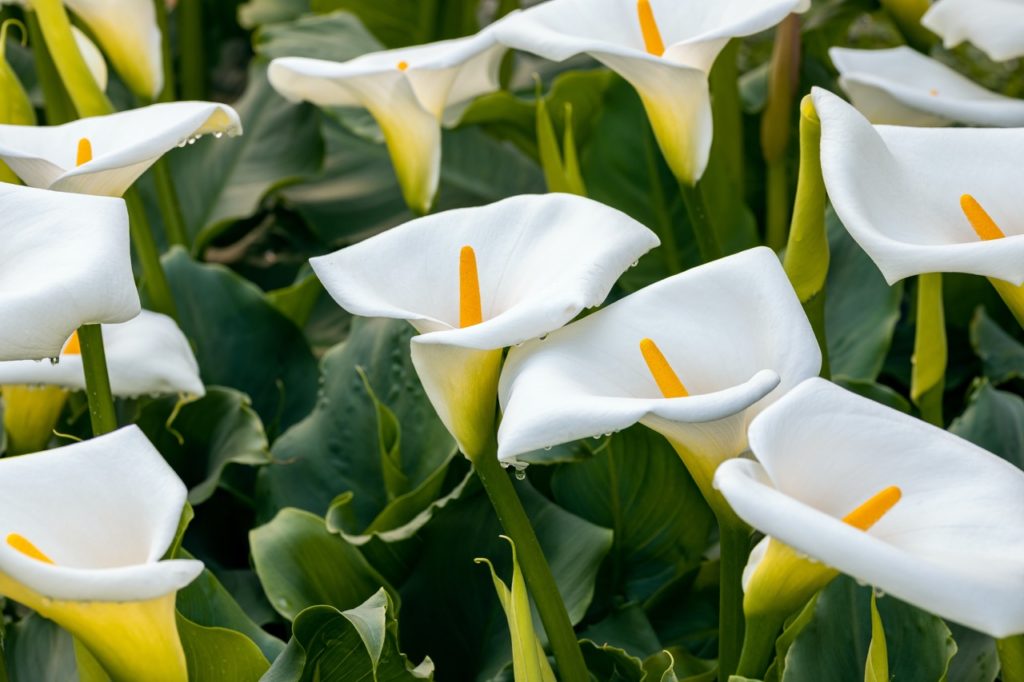
- BOTANICAL NAME: Calla aethiopica
- HARDINESS RATING: H4
- PLANT TYPE: perennial / aquatic
- FLOWERS: white and yellow
- FLOWERING SEASON(S): spring / summer
- SIZE: 0.5-1m in height, 0.1-0.5m spread
With white spathes and yellow spadices that appear in late spring, this perennial can be grown in water or in a container full of a waterlogged clay or loam-based growing medium.
Arum lilies need to be grown in a sheltered position and, if growing in a garden pond, has to be left somewhere where their roots are not disturbed.
It is also widely sold under the name Zantedeschia aethiopica.
33) Clematis ‘Lasurstern’
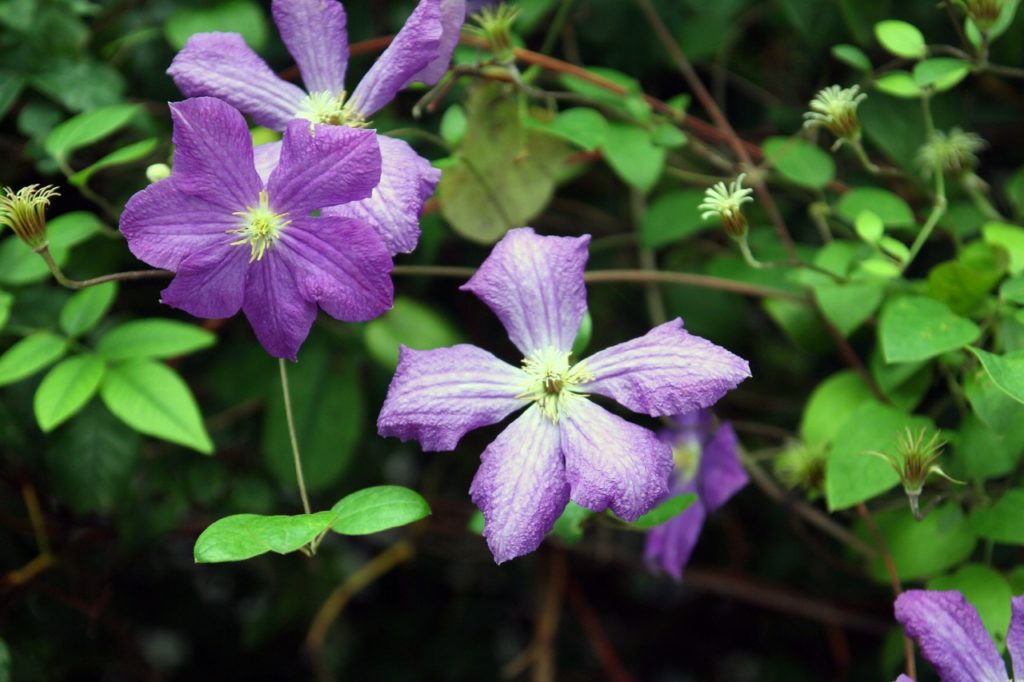
- BOTANICAL NAME: Clematis ‘Lasurstern’
- HARDINESS RATING: H6
- PLANT TYPE: climber
- FLOWERS: cream, purple and blue
- FLOWERING SEASON(S): summer
- SIZE: 1.5-2.5m in height, 0.5-1m spread
Another purple flowering gem, C. ‘lasurstern’ is a climbing shrub that is an excellent choice for growing against a wall or trellis and can reach heights of up to 2.5m.
Its star-shaped blooms appear from May and last well into the summer months.
Like many clematis varieties, ‘Lasurstern’ is a relatively low-maintenance shrub once it is planted out in a suitable location.
34) Common Dog Violet
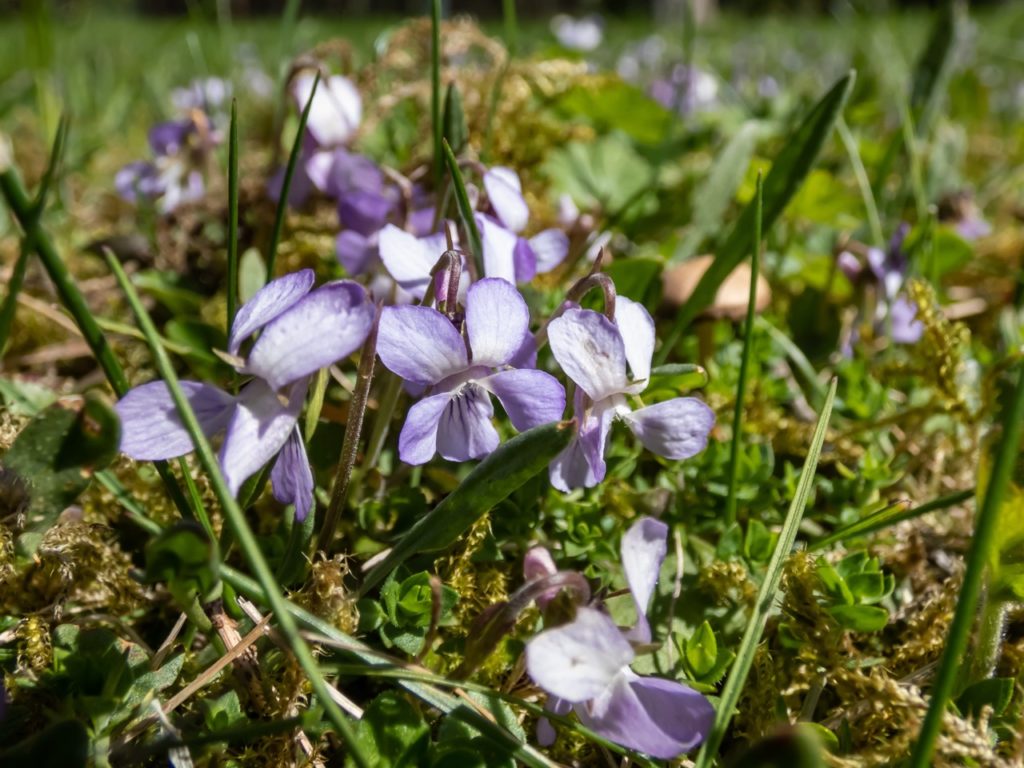
- BOTANICAL NAME: Viola riviniana
- HARDINESS RATING: H7
- PLANT TYPE: perennial
- FLOWERS: purple
- FLOWERING SEASON(S): spring / summer
- SIZE: 0-0.1m in height, 0.1-0.5m spread
Viola riviniana, or common dog violet, is a fully-hardy perennial with heart-shaped leaves and produces violet-coloured blooms from May onwards.
With a preference for acidic soil, this versatile plant can be grown in full shade or full sun and is a great choice for filling in gaps in borders or beds.
If it likes its spot, it will seed and spread.
35) Purple Spiderwort

- BOTANICAL NAME: Tradescantia pallida ‘Purpurea’
- HARDINESS RATING: H3
- PLANT TYPE: houseplant / perennial
- FLOWERS: pink
- FLOWERING SEASON(S): summer
- SIZE: 0.1-0.5m in height, 0.1-0.5m spread
Purple spiderwort is best known for its – you guessed it – purple evergreen foliage that provides visual interest all year round.
However, it also bears tiny, bright pink flowers from May until September which stand out against the dark leaves.
Often grown as a houseplant, I’d recommend planting this spiderwort variety in a container so it can be grown outside in the summer, then moved inside during colder months for winter protection.
36) Common Lilac
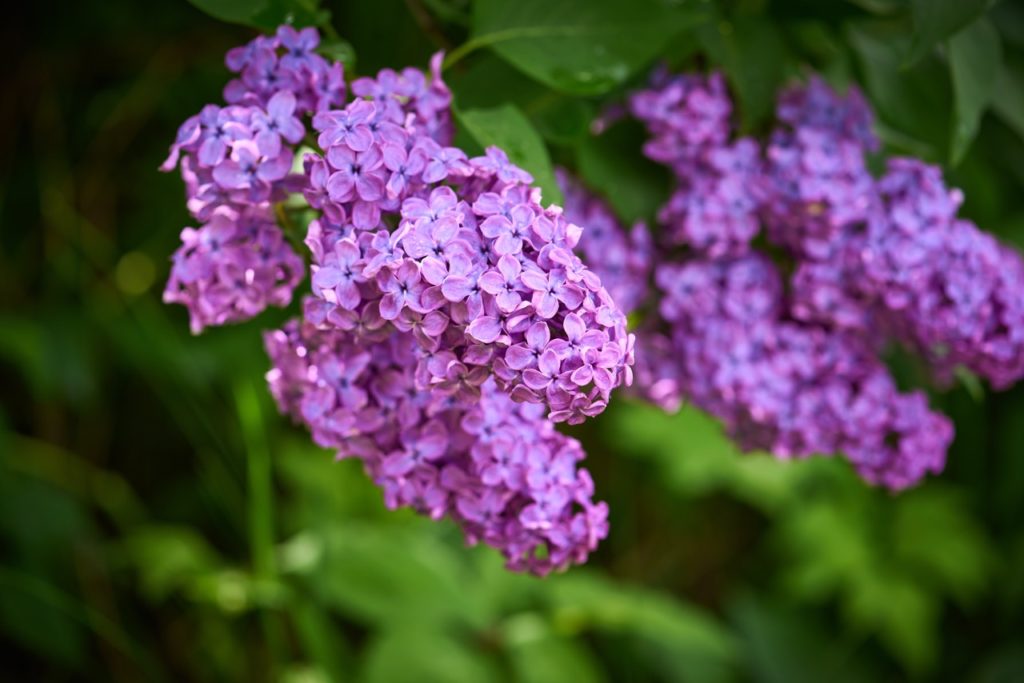
- BOTANICAL NAME: Syringa vulgaris
- HARDINESS RATING: H6
- PLANT TYPE: shrub
- FLOWERS: pink and blue
- FLOWERING SEASON(S): spring / summer
- SIZE: 4-8m in height, 4-8m spread
With clusters of tiny star-shaped pink or blue blooms that grow at the end of drooping stems, lilac is a deciduous shrub that can grow up to 8m.
This shrub is favoured in traditional cottage gardens, but will only grow to its best if it is planted in soil with an alkaline pH.
37) Magnolia ‘Susan’
- BOTANICAL NAME: Magnolia ‘Susan’
- HARDINESS RATING: H6
- PLANT TYPE: tree / shrub
- FLOWERS: pink
- FLOWERING SEASON(S): spring
- SIZE: 2-4m in height, 2-4m spread
An impressive tree, Magnolia ‘Susan’ produces deep pink flowers in April and May.
It forms a distinctive shape, with large leaves and smooth, pale bark.
38) Black Parsley
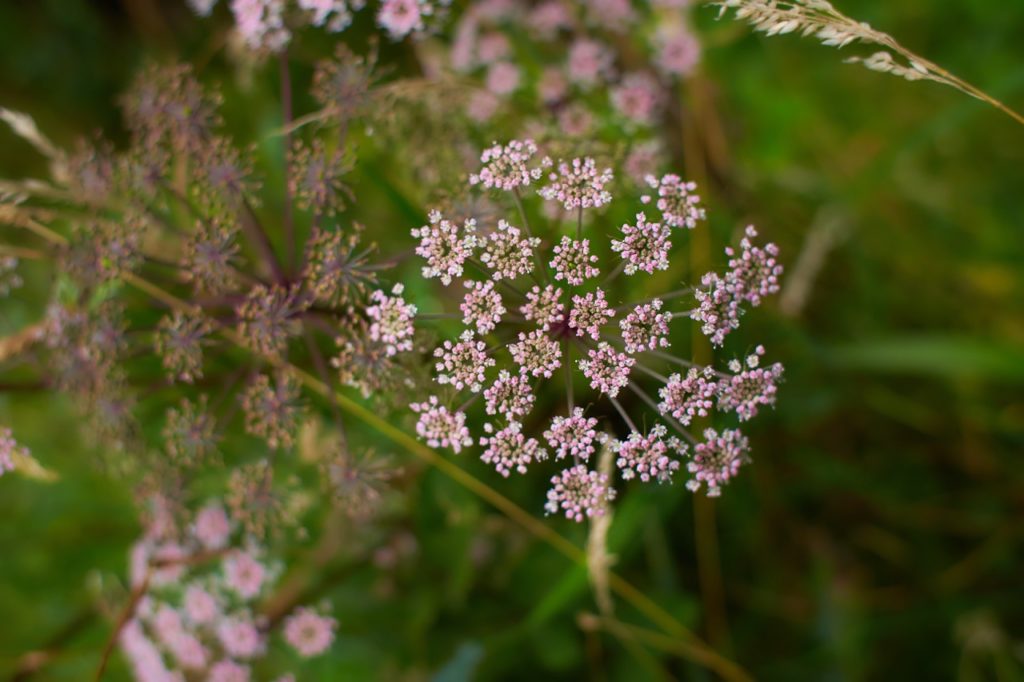
- BOTANICAL NAME: Melanoselinum decipiens
- HARDINESS RATING: H3
- PLANT TYPE: perennial
- FLOWERS: pink
- FLOWERING SEASON(S): spring / summer
- SIZE: 1.5-2.5m in height, 1-1.5m spread
Black parsley is a May-flowering perennial that produces clusters of tiny pink flowers and would make a great addition to a more natural garden planting scheme.
As a half-hardy perennial, I’d suggest keeping an eye on this plant over the winter months, and it definitely wouldn’t hurt to apply a thin layer of mulch before the first frosts kick in.
39) Blue Poppy
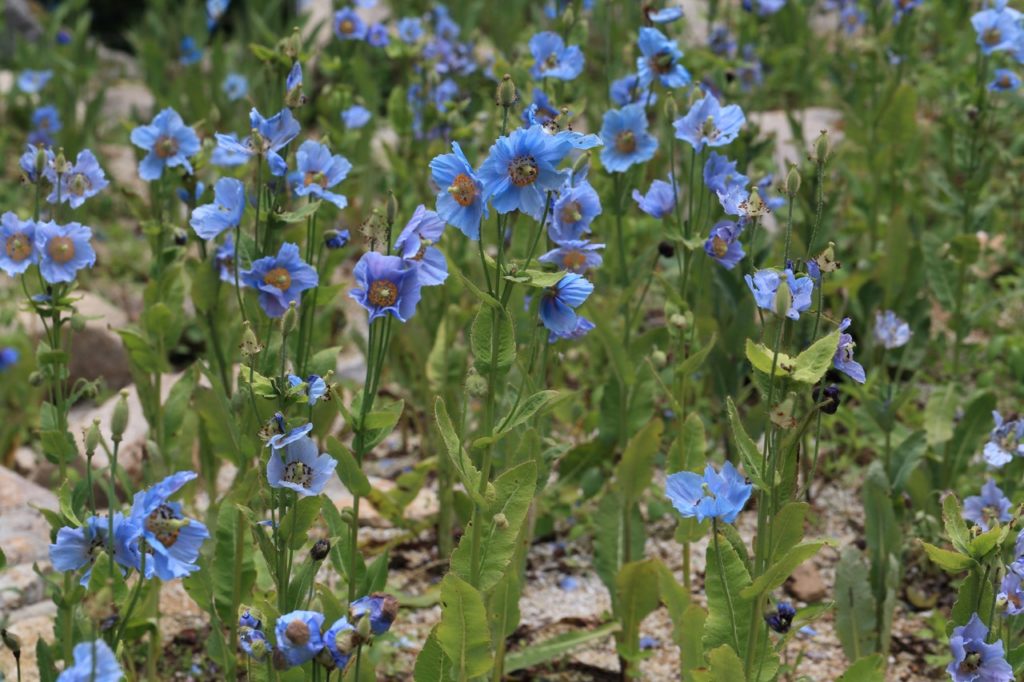
- BOTANICAL NAME: Meconopsis betonicifolia
- HARDINESS RATING: H4
- PLANT TYPE: perennial
- FLOWERS: blue
- FLOWERING SEASON(S): summer
- SIZE: 1-1.5m in height, 0.1-0.5m spread
This perennial is short-lived and is often treated as an annual here in the UK, but if you want lovely blue blooms from May into the summer months, few do this better than the blue poppy.
Best grown in clay or loam soil with an acidic pH, this half-hardy plant grows best in partial shade in a sheltered location.
It can be a challenge to get them to flower, but annual mulching with leaf mould can help.
40) Mexican Mock Orange
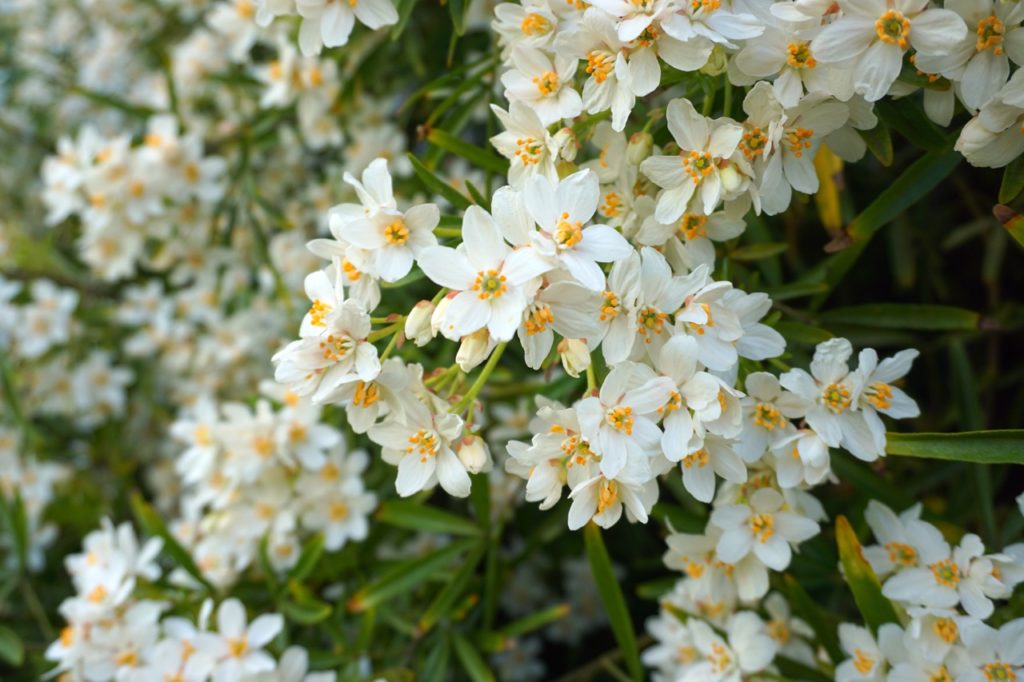
- BOTANICAL NAME: Philadelphus mexicanus
- HARDINESS RATING: H3
- PLANT TYPE: shrub
- FLOWERS: white and cream
- FLOWERING SEASON(S): summer
- SIZE: 1.5-2.5m in height, 1.5-2.5m spread
Philadelphus mexicanus, or Mexican mock orange, produces aromatic clusters of creamy-white flowers from woody stems in May that last into the summer.
This bushy shrub would look great at the back of a garden bed and can even be used as a small hedge for dividing up your garden displays.
41) Renard Geranium

- BOTANICAL NAME: Geranium renardii
- HARDINESS RATING: H6
- PLANT TYPE: perennial
- FLOWERS: white and purple
- FLOWERING SEASON(S): summer
- SIZE: 0.1-0.5m in height, 0.1-0.5m spread
With white, star-shaped flowers that flaunt purple-coloured veins, the Renard geranium is a deciduous perennial that can bloom from May onwards.
It grows to no more than 50cm in height and spread, making it a great choice for underplanting larger flowering shrubs and plants.
42) Turban Lily
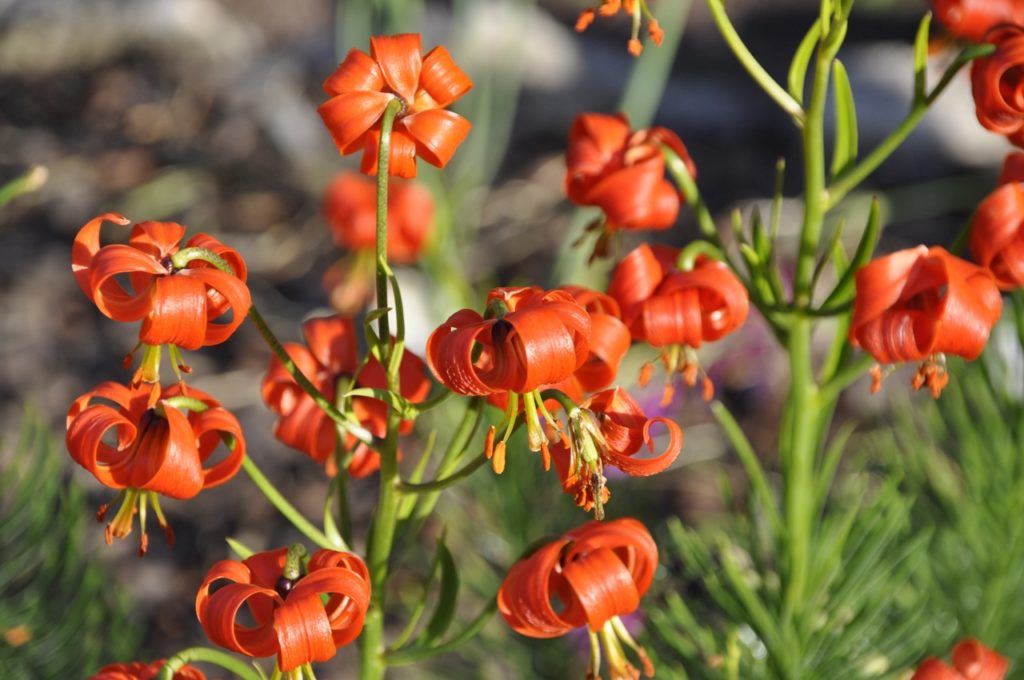
- BOTANICAL NAME: Lilium pomponium
- HARDINESS RATING: H7
- PLANT TYPE: perennial / bulb
- FLOWERS: orange and red
- FLOWERING SEASON(S): summer
- SIZE: 1-1.5m in height, 0.1-0.5m spread
The turban lily is a unique bulbous perennial that produces downward-facing red flowers with petals that peel back to reveal orange stamen.
This is a rare lily, as it is notoriously difficult to grow, but if you have the time and patience, these blooms are sure to reward if and when they finally appear.
43) Narrow-Leaved Sundrops

- BOTANICAL NAME: Oenothera fruticosa
- HARDINESS RATING: H5
- PLANT TYPE: perennial
- FLOWERS: yellow
- FLOWERING SEASON(S): summer / autumn
- SIZE: 0.5-1m in height, 0.5-1m spread
Producing beautiful, bright yellow blooms from as early as May until September, Oenothera fruticosa, also known as narrow-leaved sundrops are hardy perennials that are beloved by pollinators here in the UK.
Sundrops need to be grown somewhere in full sun where they will be sheltered from any harsh winds.
With less shelter, they tend to bloom later, so May flowers are not always achievable.
44) Mediterranean Spurge
- BOTANICAL NAME: EUPHORBIA CHARACIAS
- HARDINESS RATING: H4
- PLANT TYPE: PERENNIAL
- FLOWERS: YELLOW / GREEN / RED
- FLOWERING SEASON(S): LATE SPRING
- SIZE: 1-1.5M HIGH, 1-1.5M SPREAD
“Few perennials are as architectural as the Mediterranean spurge, with its blue-green leaves carried on elegant spikes throughout the year,” shares Peter.
“Flowers start in mid-spring and continue into May, with a zingy yellow-green colour.
“Red centres in the flowers can be picked up by planting red Camellias or peonies nearby, which will contrast delectably with the acid green of the spurge.”
45) Rose ‘Canary Bird’
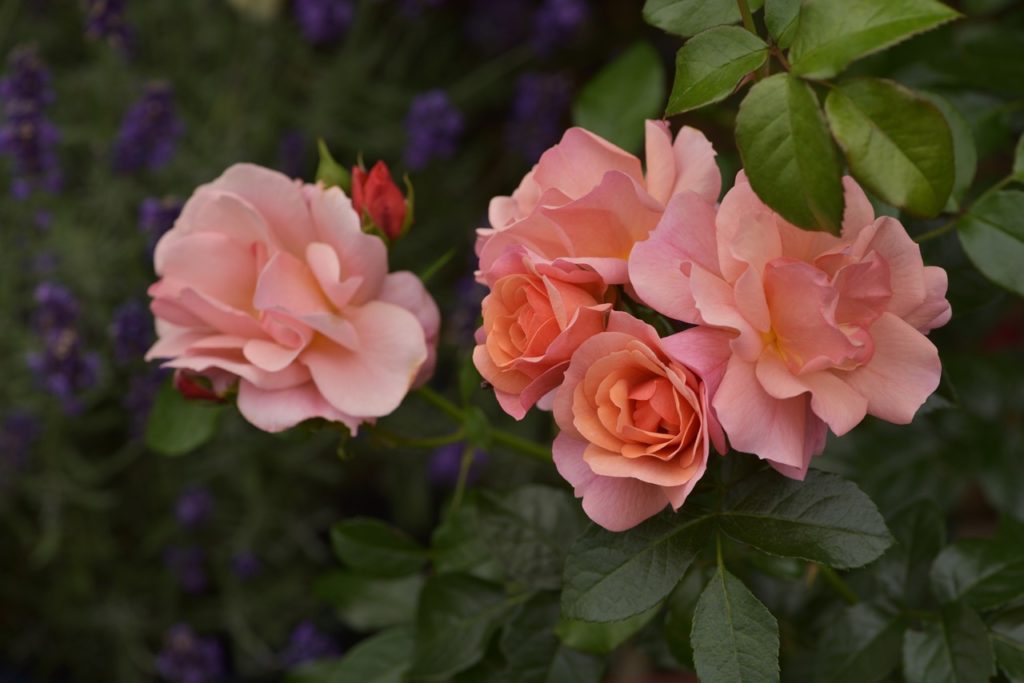
- BOTANICAL NAME: Rosa xanthina ‘Canary Bird’
- HARDINESS RATING: H6
- PLANT TYPE: shrub
- FLOWERS: orange and pink
- FLOWERING SEASON(S): summer / autumn
- SIZE: 1.5-2m in height, 1-3m spread
To conclude this list, I’ve chosen a May-flowering classic – the rose.
‘Canary Bird’ is a large shrub rose, with creamy yellow flowers that can be relied upon to bloom in May, ahead of other roses.
With a bushy habit, this rose can grow in many garden displays as long as it is planted in a sheltered location where it will get plenty of sun throughout the day.


